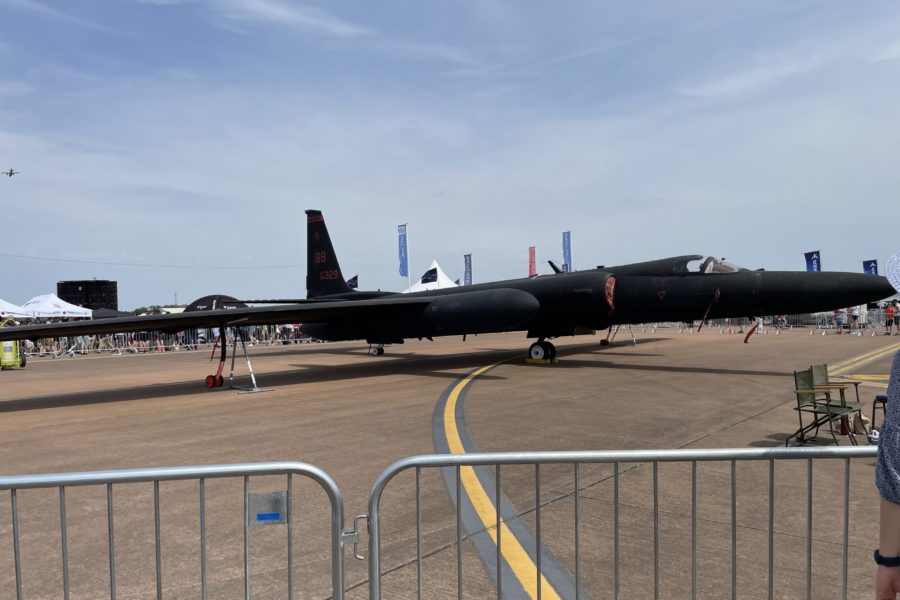RAF FAIRFORD, U.K.—At the end of a row of fighter jets at July’s Royal International Air Tattoo, an entirely different kind of aircraft drew plenty of attention from the thousands in attendance—the U-2S Dragon Lady.
Long shrouded in secrecy, the legendary high-altitude intelligence, surveillance, and reconnaissance aircraft has been seen in the skies over RAF Fairford with increasing regularity over the past few years. But even for local aviation enthusiasts, the chance to see the plane up close represented a unique opportunity.
“In the general media and [from] some of the locals, we’ve already gotten feedback. They’ve been here for years, and I’ve seen quite a few … comments on how surprised they were that they were able to get that close to a U-2,” Lt. Col. Jeremy Stover, commander of the 420th Air Base Squadron at Fairford, told Air Force Magazine.
“We have very active, what we call spotters, aircraft spotters, off base. Our perimeter fence is right at the edge of the runway, and so people will populate that road right outside the base and be out there taking pictures. So I see it posted online on Facebook and other media sites. They post a lot of pictures, and they’re huge aviation fans. And so I think for a lot of them to get that close, it was a really significant event for them.”
It is hardly surprising that the U-2’s inclusion generated excitement—it hasn’t been seen at RIAT since the 2017 airshow. Before that, it hadn’t been on display there since 2005.
However, putting the U-2 on display this year involved significantly fewer logistical challenges than in years past. U-2s have been operating out of Fairford since 2019, after the Air Force deployed the 99th Expeditionary Reconnaissance Squadron out of Beale Air Force Base, Calif.
Their missions are kept secret, but their imposing, unique presence has garnered plenty of interest among the general public—and kept the Airmen deployed to RAF Fairford busy on a day-to-day basis.
“Currently, we support the deployed U-2 squadron. They’ll fly one or two sorties a day, roughly 20 sorties a month,” Stover said. And that’s kind of our steady state battle rhythm, if you will. So it’s mostly flying Monday through Friday.”
For several years prior to the U-2, RAF Fairford did not have consistent airfield operations. The Air Force started withdrawing its uniformed personnel from the base in 2010, keeping it on standby for heavy bomber operations. Over time, bombers have regularly rotated through as part of exercises in Europe.
None, however, have stayed as long as the U-2, and the 99th ERS continues to deploy Airmen to the base.
“They have a permanent party military commander and director of operations, and then they have roughly 50 deployed Airmen,” Stover said. “They’re mostly maintenance. They’ve got some contractors. So they do the maintenance and the generation of the aircraft itself.”
The 420th ABS, meanwhile, stood up the 420th Expeditionary Air Base Squadron to support the 99th, providing everything else needed to keep the U-2 flying and the Airmen supporting it going.
“We brought in roughly 70 to 80 deployed base operations support Airmen to support that footprint,” Stover said. “So … what did that mean in terms of [career fields]? So we’re talking airfield operations, so air traffic control, airfield managers, we call them RAWS [Radar, Airfield, and Weather Systems], civil engineers, security forces is a very significant footprint obviously for the U-2s. So that makes up roughly half of that deployed footprint to provide security for the U-2 aircraft. And then we also have a few logistics. So from that perspective we have to provide all the necessary base operations support requirements.”
It’s an extensive list of responsibilities, in addition to the bomber task force and agile combat employment missions that are regularly staged out of the base, Stover said. How long it will continue—and how likely it is that spectators will get to see the U-2 at RIAT—remains to be seen, Stover said.
“I will say the [U.S. Air Forces in Europe] staff came out last fall or winter to kind of readdress that decision and look at, does it make sense to keep them at Fairford? Does it make sense to try to locate them somewhere else?” Stover said. “And ultimately, the feedback that I received was [that] for the immediate future, they’re going to continue to operate out of Fairford. But I couldn’t say how much longer.”
